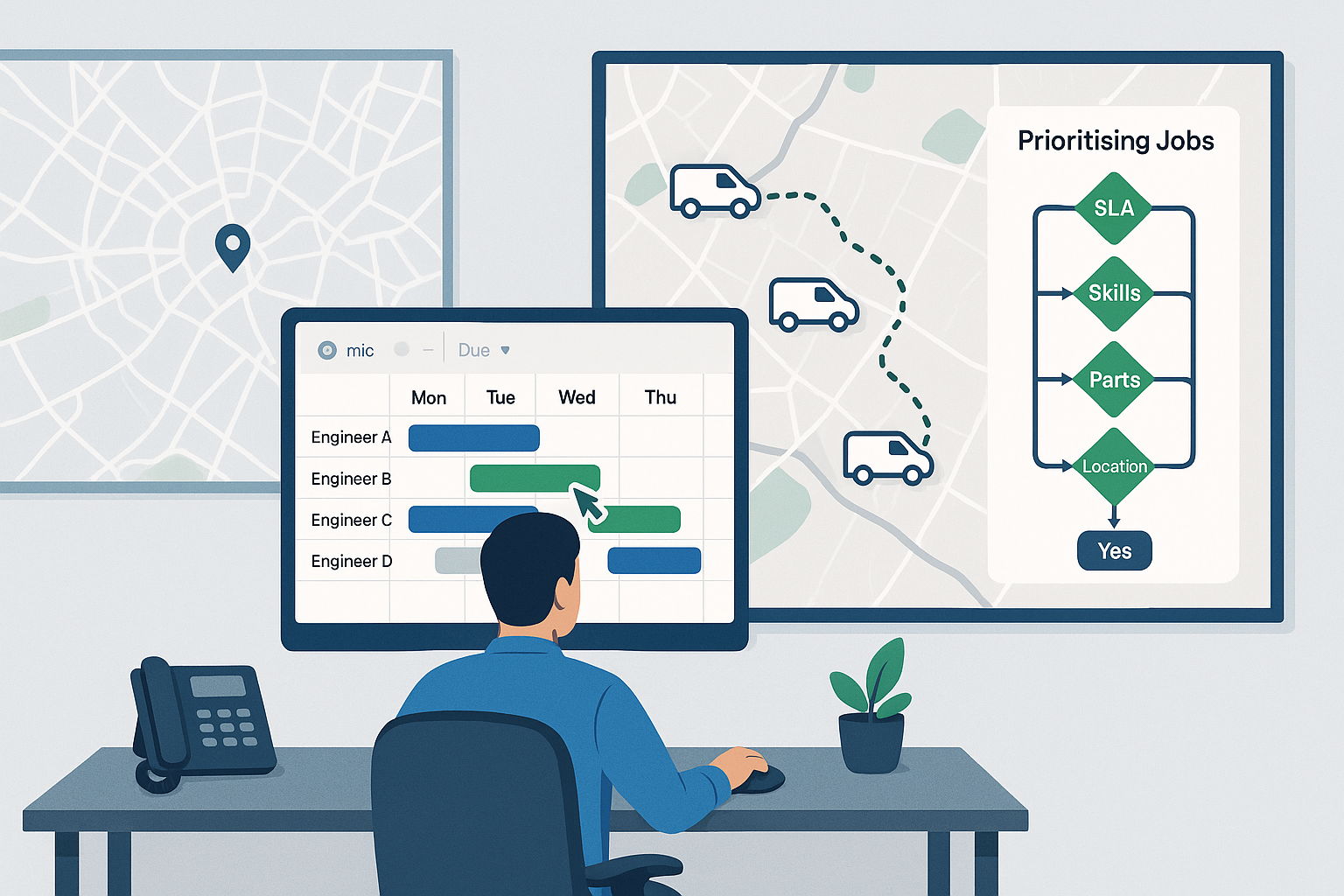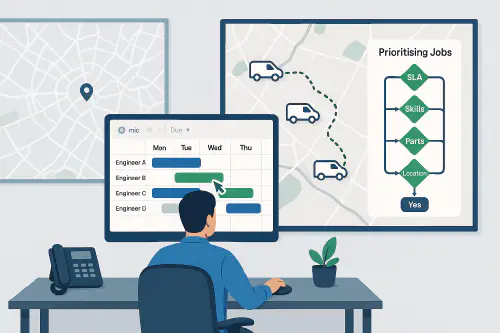
Dispatcher playbook for trades: scheduling engineers, priorities, routes and on-the-day swaps
Category: Case Studies and Playbooks Niche: Dispatch, scheduling, route optimisation, job management
Contents
- Quick answer
- Who this is for
- Set up checklist
- Day-before planning rules
- Live dispatch rules
- Route optimisation basics
- Data you must keep clean
- UK specific constraints to model
- A simple scoring model you can copy
- KPIs that prove it is working
- 90 day rollout plan
- Recommended tools
- FAQ

Dispatch desk with UK map, engineer schedule and routing flow
Quick answer
If you want fewer missed appointments, lower miles and happier customers, set three foundations and stick to them.
- Reserve capacity. Keep 15 to 25 percent of hours free per region for same day calls and emergencies.
- Gate by skills and parts. Only book jobs to qualified engineers with parts in hand unless you are doing diagnosis only.
- Re-optimise with rules. Re-calc ETAs and reroute on triggers like cancellations, overruns and new emergencies. Only swap if it improves SLA risk.
Link these with clear customer updates and you will raise on time arrival and first time fix without burning the team.
Who this is for
- Electrical, plumbing, HVAC, roofing and facilities maintenance teams with two to two hundred engineers.
- Owners, ops managers and dispatchers who want fewer fires and more predictable days.
- Companies using job management software but still firefighting diaries.
Useful companion reads in the Academy:
- WhatsApp booking bot for trades. Creates better bookings and deposits. Read it
- Skills matrix linked to scheduling. Stops unsafe assignments. Read it
- Email to job automation. Turns enquiry emails into ready to schedule jobs. Read it
Set up checklist
- Define SLA tiers and booking windows for each tier.
- Create a simple skills and permits matrix for every engineer. Track expiries.
- Record van stock by engineer and top twenty parts by region and season.
- Add parking and access notes to job templates. Capture on first visit.
- Decide your reserve capacity by day and region.
- Decide swap rules and who can authorise them.
- Turn on customer notifications for confirmations, on route and delays.
Day-before planning rules
- Triage each job. Emergency, urgent same day, planned or PPM.
- Hold back 15 to 25 percent capacity for same day work.
- Skills gate. Only schedule to engineers with the right tickets that will not expire mid job.
- Parts gate. Only plan work when parts and tools are confirmed, unless it is diagnosis only.
- Geo zones. Cluster work by postcode district to cut dead miles.
- Realistic buffers. Add time for parking, access and school run traffic.
- Safety. Enforce breaks and lone worker check ins in the plan.
Live dispatch rules
- Re-optimise every 15 to 30 minutes or on triggers. Overruns, cancellations, traffic spikes or new emergencies.
- Limit churn. Do not change an engineer’s day more than necessary. Protect two nearest jobs unless SLA risk demands it.
- Swap only when SLA risk improves and the receiving engineer has the skills and parts.
- Update ETAs after every change and send customers a fresh time.
- Have exception playbooks. No access, unsafe conditions or missing parts should auto propose the next best nearby job.
Route optimisation basics
At a high level this is a vehicle routing problem with time windows. You will get most of the gain by clustering nearby jobs then routing inside the cluster.
- Constraints to consider: promised windows, service time, skills, parts, depot start and end, breaks, max daily driving, tolls and clean air zones, parking and building access windows.
- Cost to minimise: distance, travel time, overtime penalties and missed SLA risk.
Watch a short route optimisation demo that mirrors this logic. Field Service Route Optimization Demo on YouTube
Data you must keep clean
- Engineer skills and credentials. Gas Safe, 18th Edition, F Gas, CSCS where required.
- Availability and vehicles. Shifts, holidays, and EV versus diesel for zone charges.
- Job data. Priority, window, access notes, expected duration, parts needed.
- Geography. Postcodes with lat and long, typical travel times and parking time by area.
- Inventory. Van stock and micro hub stock with courier cut offs.
- Historicals. Actuals versus plan, no access rates and repeat visits.
UK specific constraints to model
- Urban charges. Congestion and low emission zones. Price them into your routing cost.
- Parking rules. Controlled zones and common access delays by area.
- Working time. Breaks and rest between shifts.
- Rural work. Longer windows and more clustering to avoid dead miles.
- Events and bank holidays. Reduce capacity or widen windows on those days.
A simple scoring model you can copy
Use this to pick the best engineer for a job. Tune weights using your outcomes.
score = 5*SLA_priority + 5*current_SLA_risk + 4*skill_match + 3*parts_ready
- 3*travel_time - 2*overtime_penalty - 1*zone_toll_cost
- 1*schedule_churn - 1*parking_difficulty
Tip. Penalise SLA risk heavily so priority work stays protected.
KPIs that prove it is working
- On time arrival by SLA tier.
- First time fix and repeat visit rate.
- Travel versus wrench time. Aim above sixty five percent wrench time in dense areas.
- Jobs per engineer per day by trade.
- Schedule stability. Fewer late changes.
- Miles per job and fuel or energy per job.
- Missed breaks and overtime hours.
- No access and cancellation rates.
- Cost per job and complaints.
90 day rollout plan
- Weeks 1 to 3. Clean master data. Set SLA tiers, capacity buffers and swap rules. Capture access notes and photos.
- Weeks 4 to 6. Pilot in one region. Turn on live ETA messages. Measure your baseline.
- Weeks 7 to 9. Add parts gating and micro hubs. Introduce re optimisation on triggers. Tune your scoring weights.
- Weeks 10 to 13. Expand to more regions. Add EV routing if relevant. Set quarterly optimisation reviews.
Recommended tools
These examples are common in UK trades. Pick one that fits your size and process.
- Commusoft. Strong diaries, dispatch and customer comms. Service dispatch software
- Tradify. Simple scheduling and dispatch flows for small teams. Scheduling features
- Joblogic. Drag and drop scheduling with dispatch. Job scheduling
- Route planners for complex days. OptimoRoute and Routific both support skills and time windows.
FAQ
What size team needs proper dispatch rules?
Even three to five engineers benefit. Reserve capacity and clear swap rules reduce chaos and weekend overtime.
How much capacity should I hold back for same day work?
Start with fifteen percent in rural areas and up to twenty five percent in dense urban zones. Review monthly.
Do I need a route optimisation tool or will a job system do?
Most job systems are enough until you have many tight windows or heavy emergency work. Add a specialist route tool when miles, late arrivals or overtime rise.
How do I improve first time fix?
Predict likely parts from history, keep van stock tuned to the top faults and do not release jobs without parts unless you plan diagnosis first.
What should I send customers on the day?
Send an on route message with live ETA, plus quick replies for delays and access issues. Keep the phone number visible.